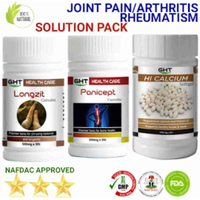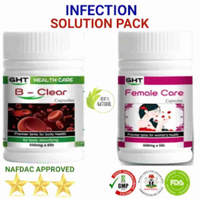
Integrative Health & Wellness Supplement Mall
Plot 38, Savvypass Plaza, Off East/west Road,port Harcourt, Portharcourt-alakahia-upth, Rivers
Last seen ... ago
Staph Infection For Women
Delivery Fee:
No location set yet, click here to set location to view delivery price
100% Payment Security
Payments on our platform is 100% safe and secured
Everything at your doorstep
Routine delivery to your doorstep
DEFINITION Staph infections are caused by staphylococcus bacteria, types of germs commonly found on the skin or in the nose of even healthy individuals. Most of the time, these bacteria cause no problems or result in relatively minor skin infections. But staph infections can turn deadly if the bacteria invade deeper into your body, entering your bloodstream, joints, bones, lungs or heart. A growing number of otherwise healthy people are developing life-threatening staph infections. Treatment usually involves antibiotics and drainage of the infected area. However, some staph infections no longer respond to common antibiotics. SYMPTOMS Staph infections can range from minor skin problems to Endocarditis, a life-threatening infection of the inner lining of your heart (endocardium). As a result, signs and symptoms of staph infections vary widely, depending on the location and severity of the infection. Skin infections Skin infections caused by staph bacteria include: Boils. The most common type of staph infection is the boil, a pocket of pus that develops in a hair follicle or oil gland. The skin over the infected area usually becomes red and swollen. If a boil breaks open, it will probably drain pus. Boils occur most often under the arms or around the groin or buttocks. Impetigo. This contagious, often painful rash can be caused by staph bacteria. Impetigo usually features large blisters that may ooze Fluid and develop a honey-colored crust. Cellulitis. Cellulitis — an infection of the deeper layers of skin — causes skin redness and swelling on the surface of your skin. Sores (ulcers) or areas of oozing discharge may develop, too. Cellulitis occurs most often in the lower legs and feet. Staphylococcal scalded skin syndrome. Toxins produced as a result of a staph infection may lead to staphylococcal scalded skin syndrome. Affecting mostly newborns and children, this condition features Fever, a rash and sometimes blisters. When the blisters break, the top layer of skin comes off — leaving a red, raw surface that looks like a burn. Food poisoning Staph bacteria are one of the most common causes of Food poisoning. Symptoms come on quickly, usually within hours of eating a contaminated food. Symptoms usually disappear quickly, too, often lasting just half a day. A staph infection in food usually doesn't cause a Fever. Signs and symptoms you can expect with this type of staph infection include: Nausea and vomiting Diarrhea Dehydration Low blood pressure Bacteremia Also known as blood poisoning, bacteremia occurs when staph bacteria enter a person's bloodstream. A Fever and low blood pressure are signs of bacteremia. The bacteria can travel to locations deep within your body, to produce infections affecting: Internal organs, such as your brain, heart or lungs Bones and muscles Surgically implanted devices, such as artificial joints or cardiac pacemakers Toxic shock syndrome This life-threatening condition results from toxins produced by some strains of staph bacteria and has been linked to the use of certain types of tampons, skin wounds and surgery. It usually develops suddenly with: A high Fever Nausea and vomiting A rash on your palms and soles that resembles sunburn Confusion Muscle aches Diarrhea Abdominal pain Septic arthritis Septic arthritis is often caused by a staph infection. The bacteria often target the knees, but other joints can be affected, including your ankle, hip, wrist, elbow, shoulder or spine. Signs and symptoms may include: Joint swelling Severe pain in the affected joint Fever When to see a doctor Go to the doctor if you or your child has: An area of red, irritated or painful skin Pus-filled blisters Fever You may also want to consult your doctor if: Skin infections are being passed from one family member to another Two or more family members have skin infections at the same time CAUSES Many people carry staph bacteria and never develop staph infections. However, if you develop a staph infection, there's a good chance that it's from bacteria you've been carrying around for some time. These bacteria can also be transmitted from person to person. Because staph bacteria are so hardy, they can live on inanimate objects such as pillowcases or towels long enough to transfer to the next person who touches them. Staph bacteria are able to survive: Drying Extremes of temperature High levels of salt RISK FACTORS A variety of factors — ranging from the status of your immune system to the types of sports you play — can increase your risk of developing staph infections. Underlying health conditions Certain disorders or the medications used to treat them can make you more susceptible to staph infections. People who may be more likely to get a staph infection include those with: Diabetes who use insulin HIV/AIDS Kidney failure requiring dialysis Weakened immune systems — either from a disease or medications that suppress the immunes system Cancer, especially those who are undergoing chemotherapy or radiation Skin damage — from conditions such as eczema to insect bites or minor Trauma that opens the skin Respiratory illness, such as Cystic fibrosis or Emphysema Current or recent hospitalization Despite vigorous attempts to eradicate them, staph bacteria remain present in hospitals, where they attack the most vulnerable, including people with: Weakened immune systems Burns Surgical wounds Invasive devices Staph bacteria can travel along the medical tubing that connects the outside world with your internal organs. Examples include: Dialysis Urinary catheters Feeding tubes Breathing intubation Intravascular catheters Contact sports Staph bacteria can spread easily through cuts, abrasions and skin-to-skin contact. Staph infections may also spread in the locker room through sharing razors, towels, uniforms or equipment. Unsanitary food preparation Food handlers who don't properly wash their hands can transfer staph from their skin to the food they're preparing. Foods that are contaminated with staph look and taste like normal. COMPLICATIONS If staph bacteria invade your bloodstream, you may develop a type of infection that affects your entire body. Called Sepsis, this infection can lead to septic Shock — a life-threatening episode with extremely low blood pressure. PREPARING FOR YOUR APPOINTMENT While you may initially consult your family physician, he or she may refer you to a specialist, depending on which of your organ systems is affected by the infection. For example, a dermatologist specializes in skin conditions, while a cardiologist treats heart disorders. Or you may be referred to a doctor who specializes in Infectious diseases. What you can do You may want to write a list that includes: Detailed descriptions of your symptoms Information about medical problems you've had Information about the medical problems of your parents or siblings All the medications and dietary supplements you take Questions you want to ask the doctor For staph infection, some basic questions to ask your doctor include: What's the most likely cause of my symptoms? What kind of tests do I need? What's the best treatment for a staph infection? Am I contagious? How can I tell if my infection is getting better or worse? Are there any activity restrictions that I need to follow? I have other health conditions. How can I best manage these conditions together? Do you have any brochures or other printed material that I can take home with me? What websites do you recommend? What to expect from your doctor Your doctor will likely ask you a number of questions, such as: When did you first notice your symptoms? Could you describe them to me? How severe are your symptoms? Have you been around anyone with a staph infection? Do you have any implanted medical devices, such as an artificial joint or a pacemaker? Do you have any ongoing medical conditions, including an impaired immune system? Have you recently been in the hospital? Do you play contact sports? TESTS AND DIAGNOSIS To diagnose a staph infection, your doctor will: Perform a physical exam. During the exam, your doctor will closely examine any skin lesions you may have. Collect a sample for testing. Most often, doctors diagnose staph infections by checking a tissue sample or nasal secretions for signs of the bacteria. TREATMENTS AND DRUGS Treatment of a staph infection may include: Antibiotics. Your doctor may perform tests to identify what type of staph bacteria is behind your infection, and to help choose the antibiotic that will work best. Antibiotics commonly prescribed to treat staph infections include certain cephalosporins, nafcillin or related antibiotics, sulfa drugs or vancomycin. Vancomycin increasingly is required to treat serious staph infections because so many strains of staph bacteria have become resistant to other traditional medicines. But vancomycin and some other antibiotics have to be given intravenously. If you're given an oral antibiotic, be sure to take it as directed, and to finish all of the medication prescribed by your doctor. Ask your doctor what signs and symptoms you should watch for that might indicate your infection is worsening. Wound drainage. If you have a skin infection, your doctor will likely make an incision into the sore to drain Fluid that has collected there. Device removal. If your infection involves a device or prosthetic, prompt removal of the device is needed. For some devices, removal might require surgery. Antibiotic resistance Staph bacteria are very adaptable, and many varieties have become resistant to one or more antibiotics. For example, only about 10 percent of today's staph infections can be cured with penicillin. The emergence of antibiotic-resistant strains of staph bacteria — often described as methicillin-resistant Staphylococcus aureus (MRSA) strains — has led to the use of alternative antibiotics with the potential for more side effects, such as vancomycin. LIFESTYLE AND HOME REMEDIES These common-sense precautions can help lower your risk of developing staph infections: Wash your hands. Careful hand-washing is your best defense against germs. Wash your hands briskly for at least 15 to 30 seconds, then dry them with a disposable towel and use another towel to turn off the faucet. If your hands aren't visibly dirty, you can use a hand sanitizer containing at least 62 percent alcohol. Keep wounds covered. Keep cuts and abrasions clean and covered with sterile, dry bandages until they heal. The pus from infected sores often contains staph bacteria, and keeping wounds covered will help keep the bacteria from spreading. Reduce tampon risks. Toxic shock syndrome is caused by staph bacteria. Since tampons left in for long periods can be a breeding ground for staph bacteria, you can reduce your chances of getting Toxic shock syndrome by changing your tampon frequently, at least every four to eight hours. Use the lowest absorbency tampon you can, and try to alternate using tampons and sanitary napkins whenever possible. Keep personal items personal. Avoid sharing personal items such as towels, sheets, razors, clothing and athletic equipment. Staph infections can spread on objects, as well as from person to person. Wash clothing and bedding in hot water. Staph bacteria can survive on clothing and bedding that isn't properly washed. To get bacteria off clothing and sheets, wash them in hot water whenever possible. Also, use bleach on any bleach-safe materials. Drying in the dryer is better than air-drying, but staph bacteria may survive the clothes dryer.
Other products from this seller
Visit store


























